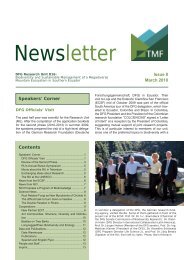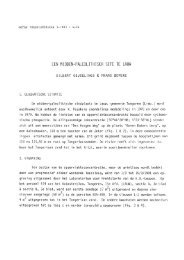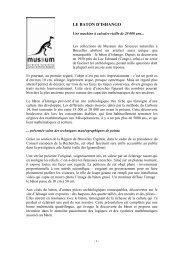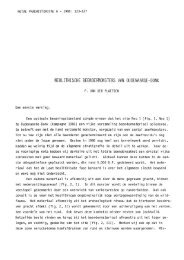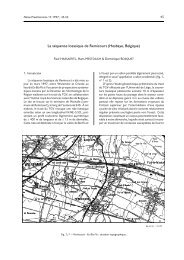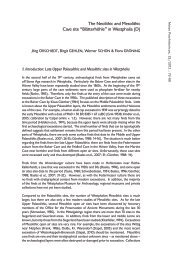Terebratula Daleidensis - Royal Belgian Institute of Natural Sciences
Terebratula Daleidensis - Royal Belgian Institute of Natural Sciences
Terebratula Daleidensis - Royal Belgian Institute of Natural Sciences
You also want an ePaper? Increase the reach of your titles
YUMPU automatically turns print PDFs into web optimized ePapers that Google loves.
72 Paul SARTENAER<br />
<strong>Terebratula</strong> nympha BaRRande, 1847 and included in<br />
it the varieties proposed by BaRRande. At the same<br />
time, she assigned OehleRt’s Rhynchonella subpareti<br />
to it, and described as nympha an Upper Emsian small<br />
form from the la Lézais trench in the Ménez-Bélair<br />
Syncline (“Département d’Ille-et-Vilaine”) assigned<br />
by SaRtenaeR (2009, p.34) to the genus Xahetomus<br />
SaRtenaeR, 2009. MoRzadec et al. (1981, fig. 4, p. 12,<br />
fig. 5, p. 14, pp. 16-17) and MoRzadec (1983, p. 276,<br />
fig. 6, p. 286) confirmed the presence <strong>of</strong> nympha in the<br />
Upper Emsian <strong>of</strong> the la Lézais trench, and mentioned it<br />
also from beds <strong>of</strong> the same age in the Reun ar C’Hrank<br />
en Lanvéoc section (“Rade de Brest”), which LaRdeux<br />
& MoRzadec (1979, pp. 14, 17) had already reported<br />
Stenorhynchia nympha from.<br />
This brings up questions regarding the presence <strong>of</strong><br />
the Bohemian species in the Armorican Massif and the<br />
contents <strong>of</strong> the genus Stenorhynchia. The presence <strong>of</strong><br />
nympha in the Armorican Massif, covering the form<br />
identified and figured as such by BaRRoiS (1889) and<br />
also various other forms, has been accepted by many<br />
authors, e.g. Cailliaud (1861, p. 332), de TRomelin<br />
& LebeSconte (1876, pp. 606-607), Kay S e R (1878,<br />
p. 143: Pareti “gehört wahrscheinlich zu nympha”),<br />
OehleRt (1884, p. 416; his opinion has been mentioned<br />
above), FRech (1887, p. 410), BaRRoiS [1889, pp. 86-<br />
87, table, p. 241, p. 328, pl. V, figs 2a-e; nympha, <strong>of</strong><br />
which he had only six specimens, is figured for the first<br />
time and considered distinct from Pareti present in the<br />
same limestone (Erbray Limestone)], MauReR (1896,<br />
p. 659), Venyukov (1899, p. 157), Scupin (1906, pp.<br />
236-238, table, p. 302), Reed (1922, p. 96; refers to<br />
nympha “as figured by BaRRoiS”), Péneau (1929, p.<br />
230, table, p. 263), Le MaîtRe (1934, pp. 210-211,<br />
table, p. 229, pp. 230, 235, 239; 1944, pp. 11, 12, table,<br />
p. 20, pp. 47, 48), Comte (1959, p. 276), Havlíček<br />
(1961, p. 87), Pillet (1962, p. 49), DRot (1964, p.<br />
105). Maillieux (1931, pp. 21, 24) also indicated<br />
the presence <strong>of</strong> nympha in the Armorican Massif and<br />
envisaged the possibility that it belongs to Pareti, and,<br />
as a consequence, falls into synonymy <strong>of</strong> daleidensis),<br />
L’HotellieR-Videau, who devoted her PhD<br />
(1970) to the rhynchonellids from some outcrops in the<br />
southeastern part <strong>of</strong> the Armorican Massif, discussed<br />
neither R. pareti nor R. subpareti, but described eight<br />
distorted specimens from existing collections from the<br />
Erbray Limestone as Stegerhynchus? nympha and S.?<br />
cf. nympha. She figured three specimens representing<br />
two, probably three, taxa, none <strong>of</strong> them approaching R.<br />
Pareti or R. nympha figured by BaRRoiS (1889, pl. V,<br />
figs 2a-e, 3a-c).<br />
The Upper Emsian S. nympha from la Lézais is also<br />
not identical with the Pragian S. nympha from Bohemia<br />
(age fide Havlíček, 1961, pp. 85, 87) [Remark: the<br />
species described as S. nympha by BRice (1981) is<br />
completely different from Rhynchonella nympha<br />
described by BaRRoiS (1889)].<br />
Various characters make the Bohemian nympha<br />
distinct from the Armorican nympha: a ventral valve<br />
almost completely excavated by the sulcus, a wide and<br />
shallow sulcus with flat bottom, a larger number <strong>of</strong><br />
lateral costae (8 to 13), the almost systematic presence<br />
<strong>of</strong> parietal costae, and the absence <strong>of</strong> a connectivum<br />
[Havlíček (1961, p. 86) writes: “Das Septalium<br />
wird von ventraler Seite durch zwei dünne Fortsätze<br />
eingeengt, die den oberen Septaliumränder aufsitzen<br />
und deren freien Enden gegeneinander orientiert<br />
sind. Diese Fortsätze berühren sich jedoch niemals”;<br />
(see also fig. 29, p. 86 <strong>of</strong> Stegerhynchus nympha)].<br />
[Remark: GaRcía-Alcalde in TRuyolS-MaSSoni &<br />
GaRcía-Alcalde (1994, p. 232), taking into account<br />
a personal communication from BRice, declares<br />
that transverse serial sections made by her from two<br />
Bohemian specimens presented by Havlíček have<br />
shown a delicate tectiform connectivum in the anterior<br />
part <strong>of</strong> the septalium].<br />
Nympha from la Lézais does not belong either to<br />
the genus Stenorhynchia. “Rhynchonella” cf. subpareti<br />
from the “Pointe de l’Armorique” also cannot be<br />
assigned to the genus Stenorhynchia, and the assignment<br />
<strong>of</strong> <strong>Terebratula</strong> Nympha pseudo-livonica BaRRande to<br />
Stenorhynchia is also disputable.<br />
GaRcía-Alcalde in TRuyólS-MaSSoni &<br />
GaRcía-Alcalde (1994, pp. 232-233) included<br />
BRice’s Upper Emsian species from la Lézais in<br />
Stenorhynchia briceae GaRcía-AlcaldE, 1994, a<br />
frequent species from the upper third <strong>of</strong> the La Ladrona<br />
Formation and the basal part <strong>of</strong> the Aguión Formation <strong>of</strong><br />
the Cantabrian Cordillera, i.e. from the middle Emsian<br />
Faunal Intervals 9 to basal 12 <strong>of</strong> GaRcía-Alcalde<br />
(Remark: these Faunal Intervals are put in the Upper<br />
Emsian by Spanish geologists because they subdivide<br />
the Emsian into a Lower Emsian restricted to the lower<br />
half <strong>of</strong> the La Ladrona Formation, and an Upper Emsian<br />
corresponding to the upper half <strong>of</strong> that formation + the<br />
Aguión Formation + most <strong>of</strong> the Moniello Formation).<br />
This substitution, accepted by BRice (2000, p. 15), does<br />
not make the generic assignment more acceptable.<br />
<strong>Terebratula</strong> nympha, a characteristic species <strong>of</strong> the<br />
Konĕprusy (Pragian) Limestone, has successively been<br />
assigned to the following genera (in parentheses are<br />
indicated the main periods): Rhynchonella fiScheR<br />
de Waldheim, 1809 (1856-1963), Camarotoechia<br />
Hall & ClaRke, 1893 (1934-1990), Nymphorhynchia



